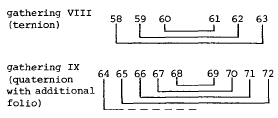Published online by Cambridge University Press: 14 July 2009
At the Third Colloquium of Scandinavian Liturgists assembled at Hanaholmen in May 1975, I distinguished two categories of liturgical chant book: (i) the books emanating from the first Carolingian renaissance – sacramentary, antiphoner, etc.; (ii) the books extracted from the preceding in the course of the second renaissance of letters and arts under Charles the Bald (840–877) and later – pontifical, troper-proser, processional.
1 This study was written at the instigation of Ritva Jonsson, director of Corpus Troporum, for the Fourth Colloquium of Scandinavian liturgists held in Lysebu near Oslo in June 1978 (cf. the Acta of the Colloquium, pp.53–65). In publishing it here I take the opportunity of dedicating it to the director of that remarkable project. (For full details of the project see this Journal, 1 (1978).)
2 See the Acta of the Third Colloquium, Hanaholmen, May 1975, pp.47–65.
3 Rasmussen, N.Kr.: Les Pontificaux du Haut Moyen-Age (Thèse de Doctorat, Institut catholique de Paris, 1978)Google Scholar
4 Hesbert, R.-J.: Corpus antiphonalium officii, v (Rome, 1977), p.25 Google Scholar
5 von den Steinen, W.: Notker der Dichter und seine geistige Welt (Berne, 1947)Google Scholar
6 Crocker, R.L.: The early medieval sequence (Berkeley and Los Angeles, 1977 – reviewed in this Journal, p.65), Chapter 1Google Scholar
7 See note in Revue de musicologie, 11 (1927), p.44 Google Scholar.
8 F-Pn Coll. de Picardie, 67, f.67 (last flyleaf), measuring 41.5 × 21.5 cm.: see Hoppin, R.H.: ‘A musical rotulus of the 14th century’, Revue belge de musicologie, 9 (1955), pp.131–142 Google Scholar; Hoppin, R.H.: ‘Some remarks à propos of Pic’, De Musicologie: Belgisch Tijdschrift voor Muziekwetenschap, 10 (1956), pp.105–112 Google Scholar. Concerning the practical use of such rolls, we may add the drawing by Grassi, Giovanni reproduced in Diapason: Ausgewählte Aufsätze von J.Smits van Waesberghe (Buren, 1976), pl.4Google Scholar; and the miniature from the manuscript F-Pn fr.1584, f.415v, reproduced in Machabey, A.: Guillaume de Machault, ii (Paris, 1955), between pp.128 and 129 Google Scholar.
9 I have reconsidered the date of this manuscript in my study of meloform tropes (cited also in n. 19 below) in Revue de musicologie, 64 (1978), p.10 Google Scholar.
10 D-Mbs lat.9543. Facs. in Bericht über den 7. internationalen Musikwissenschaftlichen Kongress Köln 1958 (Kassel and Basle, 1959), pl.VIIGoogle Scholar. Edn. of prosula text in Corpus Troporum, ii (Stockholm, 1976), p.28 Google Scholar.
11 The Breton gradual F-CHR 47, brought to Chartres in the tenth century (see Études grégoriennes, 1, 1954, pp.173–178 Google Scholar) should actually be assigned to the end of the ninth century, according to the estimate sanctioned by R.H.Bautier: see Huglo, M.: Les Tonaires (Paris, 1971), p.105, n.lGoogle Scholar.
12 Husmann, H.: Tropen- und Sequenzenhandschriften, Répertoire internationale des sources musicales, B/V/1 (Munich and Duisburg, 1964)Google Scholar
13 Björk, D.A.: The Kyrie repertory of the 10th and 11th centuries (Diss., Univ. of California, Berkeley, 1976), ii, p.12 Google Scholar
14 Seebass, Tilman: Musikdarstellung und Psalterillustration im früheren Mittelalter (Bern, 1973), pll.1–11 (in colour)Google Scholar
15 Husmann's analysis of the structure of the manuscript is incorrect, and should be rectified as follows:

16 Bevenot, M.: ‘S.Cyprian and Moissac. A thirteenth-century sequence’, Traditio, 19 (1963), pp.147–166, with four pll. from F-Pn lat.1656 ACrossRefGoogle Scholar
17 In passing, it may be remarked that some additions to the troper-proser F-Pn nouv.acq.lat.1177, which also partly concern S.Cyprian, are in exactly the same hand.
18 The Corpus Troporum research project has uncovered another important source of alleluia prosulas, D-W Gud.lat.4383, to be edited shortly.
19 This part of the article takes up some ideas presented in detail in my article on the process of the formation of tropes: ‘Aux origines des tropes d'interpolation: les tropes méloformes d'introit’. Revue de musicologie, 64 (1978), pp. 5–54 CrossRefGoogle Scholar.
20 Weakland, R.: ‘The beginnings of troping’, Musical Quarterly, 44 (1958), pp.477–488 CrossRefGoogle Scholar
21 Gautier, L.: Les tropes (Paris, 1886), p.69 Google Scholar
22 M.Huglo: article cited in n.19 above
23 Facs. of f.30v in Young, K.: The Drama of the Medieval Church (Oxford, 1953), i, pl.VIGoogle Scholar
24 As in F-Pn lat.1118: see Husmann, p.125.
25 F-MO 12 and F-A 175: see Wilmart, A.: ‘Un livret bénédictin composé à Gellone au commencement du IXe siecle’, Revue Mabillon, 12 (1922), pp. 119–133 Google Scholar.
26 See Huglo, M.: Les Tonaires (Paris, 1971), pp.15, 378 Google Scholar.
27 Ms. lat.909 was sent to the restoration department of the Bibliothèque Nationale, Paris, in December 1978: it was decided to restore it simply as it stood, and not to return to the original order of gatherings as established by Husmann (p.119), which would have involved disordering the numerical succession of folios.